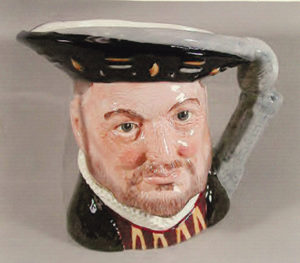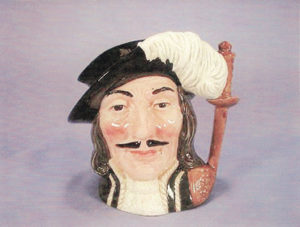 By Maureen Timm
By Maureen Timm There are many theories in regard to how Toby Fillpot was brought into the world as a character. The name “Toby” was used originally to describe jugs which were made in the form of a seated male figure in a tri cornered hat. He usually held a beer jug on his knee and sometimes held a pipe or glass in his hand. The hat was made so that each comer formed a convenient spout.
Toby was dressed in the style of the 1700s, which consisted of a full length coat with low set pockets, waistcoat, cravat, knee breeches, stockings and buckled shoes. An interesting feature of the early jugs is the hollow cap which fitted into the top of the hat and was used as a cup.
He has been associated with the fat boisterous Sir Toby Belch in Shakespeare’s “Twelfth Night,” and “My Uncle Toby” from Laurence Sterne’s “Tristam Shandy.” This book did appear about the same time as the earliest Tobies, around 1700.
Other characters who may have helped bring Toby into existence include Harry Elwes, a Yorkshireman who is alleged to have drunk two thousand gallons of strong ale from a brown jug, and who bore the nickname of Toby Fillpot. He died in 1761.
Another character was Paul Parnell, also a Yorkshireman. His obituary was in Gentleman’s Magazine dated December 1910.
 “At the Ewes Farmhouse, Yorkshire, aged 76, Mr. Paul Parnell, fanner, grazier and maltser, who during his lifetime drank out of one silver pint cup upwards of 2,000 pounds sterling worth of Yorkshire stingo, being remarkably attached to stingo tipple of the home brewed best quality. This calculation is taken at 2 pence per cupful. He was the bon vivant whom O’Keefe celebrated in more than one of his Bacchanalian songs, under the appellation of Toby Fillpot.”
“At the Ewes Farmhouse, Yorkshire, aged 76, Mr. Paul Parnell, fanner, grazier and maltser, who during his lifetime drank out of one silver pint cup upwards of 2,000 pounds sterling worth of Yorkshire stingo, being remarkably attached to stingo tipple of the home brewed best quality. This calculation is taken at 2 pence per cupful. He was the bon vivant whom O’Keefe celebrated in more than one of his Bacchanalian songs, under the appellation of Toby Fillpot.” The name Toby Fillpot occurred, probably for the first time in print in the song “The Brown Jug,” published in 1761 in a volume of “Original Poems and Translations” by the Reverend Francis Fawkes.
Although entirely original in conception, Toby was the descendant of a long line of jugs in human form fashioned by potters in earlier years.
Since the dawn of history, long before man began to record his ideas and life experiences in writing, potters have made images of living beings. Some may have been used in religious rituals and some were created for fun.
Ancient Greece provides numerous examples of jugs, cups, perfume pots and wine vessels made in the likeness of human beings, satyrs, sphinxes and other mythical creatures.
It is interesting to note that a Roman potter in Staffordshire was making face urns some fifteen hundred years before Toby made his first appearance.
In the early eighteenth century some small earthenware figures and jugs were made in Staffordshire, England. They depicted midshipmen, soldiers, musicians and other characters of that century.
These were probably made by several different potters living in and around Stoke, England. These figures appear to have been the immediate forerunners of the Toby Jug. Some of them have tri cornered hats pinched out in the front to facilitate pouring and hollow seated figures are holding jugs, pipes and beakers. They were rather crudely modeled and glazed with black blobs for eyes and buttons. However, the potters were learning to depict the everyday humor of life in rural England.
Around the 1770s an entirely new creation appeared. This was a figure jug depicting plain faced, squat bodied Toby Fillpot. The modeling and coloring far surpassed the previous earthenware figures.
The first Toby Jug was probably made between 1760 and 1770. In 1750 there were many small thatched pot works in the district of North Staffordshire which is known all over the world as “The Potteries.”
Ralph Wood I and his son, Ralph Wood II, both made figures and Toby Jugs in their factory in Burslem, the mother town of the Staffordshire potteries. They were among the first English potters to use their names, or a rebus mark of trees (i.e.wood) to identify their pottery.
The beautiful effect of the early Ralph Wood Tobies was due to the painting of colors with translucent glazes. The colors shone clear and luminous from the opaque white ground. This process was superseded by painting enamels over the glaze in opaque colors, which, though brilliant were not as delicate as the older technique.
Enoch Wood produced many figures and figure jugs from existing models including standing Tobies.
By the end of the 18th century there were many makers of Toby Jugs. Some were good, some were bad and some of indifferent quality. The art of making these jugs was introduced into the United States, probably by potters from Stoke, England who emigrated in the late 18th century.
The earliest Toby Jugs were not marked with the potter’s name and there are no written records. One potter often copied the designs of another. Because of this it is impossible to find the exact truth as to Toby’s “onlie begetter.” To this day the Toby legend remains a never ending story.
Some of the famous names associated with the early development of Toby Jugs are as follows: John Astbury (1678 1743) Ralph Wood 1 (1715 1772) Josiah Wedgwood (1730 1795) Enoch Wood (175 9 1840) Thomas Whieldon (1719 1795) Aaron Wood (1717 1785) Ralph Wood 11 (1748 1795)















Follow Us